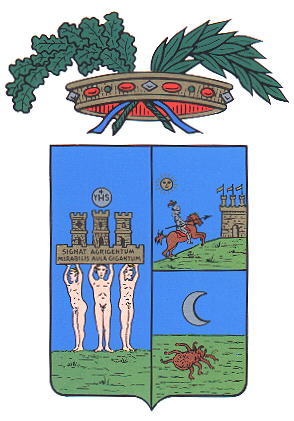Agrigento (province)
| Heraldry of the World Civic heraldry of Italy - Stemmi di comuni e province d'Italia |
AGRIGENTO
Region : Sicilia
Official blason:
Origin/meaning :
The coat of arms represents the heraldic emblems of the main city Agrigento and its two underprefectures: Sciacca and Bivona.
Agrigento began to think about an own emblem in the Middle Ages, after that the city got a more solid economical and social order under the Norman domination, a period in which it became also an important Bishop See and main city of an immense diocese. The city expanded under the Chiaramonte family and in 1402 adopted its own arms. The arms were based on the excavation of the complete cave in of the Jupiter temple (discovered at that time), with the intent to join as a symbol the splendour of the Greek art and culture with the Christian civilization. The three giants holding city with three towers, like a Greek temple, with on the central tower the Christian symbol IHS; on the platform it is written: Signat Agrigentum Mirabilis Aula Gigantum.
The upper left quarter shows the historical arms of Sciacca, an armoured warrior on an horse with a spear ready for battle, irradiated from the sun storming a fortress surmounted by three towers. The warrior symbolizes Agathokles, hero of Sciacca, conquering the three dominions of Sicily, Greece and Africa (symbolized by the three towers) that with his power and his vigour (symbolized by the sun) illuminates and makes famous his native land Sciacca and his castle Cronion. The lower left half shows the historical arms of Bivona. It represents a crescent and a spider used originally as seal by Peter, first duke of Bivona (the moon symbolizes the family of the Luna).
Literature : Le Province d'Italia, araldica e sedi storiche, 2001; background by Antonio Prencipe

